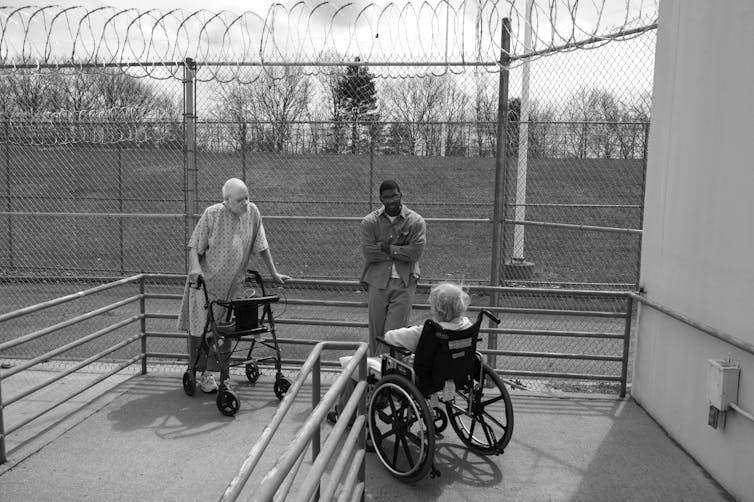Nearly a quarter of all people in U.S. prisons are 50 or older, like these inmates at FMC Devens in Massachusetts in 2015.
Angela S. Murolo, St. Francis College and Lena M. Campagna, Caldwell University
American prisons are rapidly graying.
Following decades of mass incarceration, exacerbated by the U.S. war on drugs, the proportion of older people in prison has increased since the early 1990s. Nearly a quarter of people behind bars in federal and state prisons are over age 50. That’s five times the proportion of the prison population in 1991.
Upward of 95% of incarcerated people will eventually leave prison, either on parole or because they’ve completed their sentence. And the older they are when released, the harder it can be to reintegrate into society.
Older people face greater health, housing and family obstacles after leaving prison than those under 50. As a result, they tend to rely more on parole officers and social service providers to get settled. Yet, our criminology research in New Jersey shows, there simply isn’t enough help out there to meet their needs.
‘All my friends are deceased’
Older ex-prisoners typically encounter vast challenges reacclimating to life outside of prison and supporting themselves.
Housing is a top priority. For older parolees, staying with family is often not possible. Many have cycled in and out of prison for a long time, straining their family relationships.
The case of Cosmo, who was 56 when he was interviewed in 2021 for our study, is illustrative. With a history of substance abuse and no family in New Jersey, Cosmo found himself homeless after his release from prison in 2021.
“I was assured that parole would provide me with placement somewhere,” he said.
But when he spoke to his parole officer, Cosmo said, “they told me under no uncertain terms” that they couldn’t help with housing.
Ultimately, a local social service agency got him a room at a motel. He could stay there while he found a job and saved enough money to find more permanent housing.
Daniel, a 74-year-old Vietnam veteran we interviewed, was incarcerated for seven years. During that period, his wife died. Most of his friends are gone, too.
“All my friends are deceased except for one,” Daniel said in 2021, saying the two had known each other for 69 years. “Best friends,” he added. “We met in kindergarten.”
Yet his friend was in no position to help Daniel because he was hospitalized, in failing health.
Alone in New Jersey, Daniel relied on a reentry counselor he met through his church to get his needs met. She signed him up for Medicare and Medicaid and got him a senior citizen card for transportation.
‘You’re going to educate an 80-year-old’
The hardships of prison tend to cause accelerated aging. Research shows that imprisoned people age 50 or older are much more likely to have chronic health problems or a disability than other people their age who have not been incarcerated. That’s why prisons typically designate inmates as “geriatric” at age 50 or 55.
The declining physical and mental health troubles of geriatric parolees exacerbates the already bleak job prospects for people with a criminal record. Lengthy sentences also create large gaps in their employment history and all but ensures they have limited – and often dated – skill sets to cite on applications.
All this makes it hard for older people who’ve been released from prison to provide for themselves.
“You’ve been in prison for 30 years, you don’t have the regular skills that you should,” an executive from a New Jersey community-based service provider told us in a 2024 focus group. “You don’t have the reading … other educational things that are there. And then you just don’t have the life skills.”
“So yes,” she concluded, “you’re going to educate an 80-year-old guy and teach him how to read.”
Seniors starting over
The U.S. has no single agency or organization dedicated to supporting the reentry process of geriatric parolees. They must navigate a complex patchwork of government services, nonprofit organizations and private corporations.
Geriatric parolees tend to rely on the parole system to connect them to housing and social services and to provide general guidance. Often, parole officers even teach their older clients digital literacy, so they may file job applications and claim social service benefits online.
Public and nonprofit social service agencies can help formerly incarcerated people sign up for government benefits such as Medicaid or Social Security and find housing. Nationwide, county departments of health and human services provide housing assistance, meals on wheels and other social assistance for all residents in need – regardless of criminal history.
Hundreds of nonprofit organizations offer job training, reentry support, substance abuse counseling and other services.
Daniel and Cosmo got the help they needed to restart their lives in New Jersey.
But are these support systems robust enough to support the state’s growing, graying parolee population? In New Jersey, 22% of people behind bars are 50 or older – up from 13% a decade ago.
Prisoners in a Massachusetts federal prison in 2015. Incarceration accelerates the aging process.
To answer that question, we surveyed over 400 organizations across New Jersey in 2024 and conducted focus groups with those that serve the state’s formerly incarcerated elderly population.
While nonprofits in New York, California and other states have created initiatives designed specifically to house and support older people leaving prison, we found no such programs in New Jersey.
However, our study identified a wide array of community-based groups that are equipped to help formerly incarcerated people ages 55 or older.
Hundreds of organizations work at the intersection of geriatric services and support for the formerly incarcerated, and two-thirds told us they were interested in working with parole and other community-based organizations to support older people leaving prisons. About half expressed willingness to host proven interventions for this population, such as peer-based support groups.
Such groups are rare across the U.S. because parole restricts contact between people with criminal records. But conversing with others who have experienced similar issues leaving prison provides comfort and encouragement to parolees who have limited social support – a particularly acute need for parolees over 65.
Help wanted
As the U.S. prison population ages, ever more older people will be returning to communities across the nation. They are less likely to reoffend after their release from prison. But they need more help getting back on their feet.
Ronnie, 59, found that help at a New Jersey office of the Community Resource Center, or CRC, in 2021. This national network provides reentry support with group programming to address substance abuse issues, errors in thinking and judgment, and a host of other programs.
“My main concern was housing – where I was going to live at and how I was going to support myself, jobwise,” Ronnie said.
He had been approved for $825 a month in social security benefits, but the money wasn’t enough.
“The rent is $700. So, if I’m getting $825 and I’m paying rent $700, I can’t survive on $125 bucks a month,” Ronnie said.
His CRC caseworker was working to get him into a much more affordable retirement home.
“$200 or $300, I’ll be able to handle that,” Ronnie said, “with no problem.”
Angela S. Murolo, Assistant Professor of Criminal Justice and Sociology, St. Francis College and Lena M. Campagna, Associate Professor of Criminal Justice and Sociology, Caldwell University
This article is republished from The Conversation under a Creative Commons license. Read the original article.























































